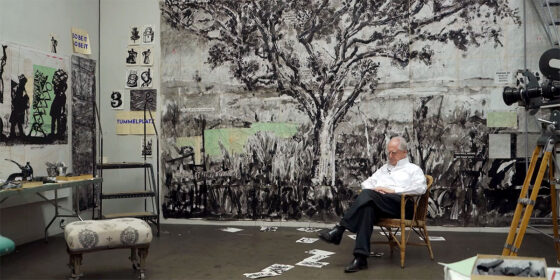TIFF 2022 | Self-Portrait as a Coffee Pot (William Kentridge, South Africa/US) — TIFF Docs

By Michael Sicinski
Is it possible that some folks were too productive during COVID? It has become a common joke that almost nobody took advantage of the quarantine to write that novel or master a new language. But William Kentridge spent that time making a nine-part documentary about himself and his work. Based on the three episodes screening at TIFF, I can say with some confidence that this is excessive. But Kentridge had a lot of time and charcoal on his hands, and so, in addition to some very interesting moments examining his working method, Kentridge filmed himself having long chats with his double (there is nearly always more than one Kentridge onscreen), dabbling in music and dance, and even engaging in a rather long riff on the Harpo Marx mirror bit. In short, it’s all Kentridge all the time.
In a much shorter form, Self-Portrait as a Coffee Pot could have been an intellectually satisfying profile of one of the most significant artists working today. Kentridge has been combining drawing and film for some time now, most notably in his animated “Soho Eckstein” cycle from the early aughts. Those works, in which Kentridge combined ruminations on a love triangle amidst the final days of Apartheid, were powerful because they combined tactility with a historical narrative. His filming of the evolution of the drawings was a way of capturing various registers of time, like a handmade version of Marey’s chronophotography. And while this is still the heart of his method, he is mostly applying it to self-portraits and still lives that simply lack the frisson of the earlier work.
A film about an artist should probably make you appreciate their work more. That’s certainly been the case with recent documentaries on Gerhard Richter and Anselm Kiefer, or the 1999 Kartemquin profile of Leon Golub. The common denominator among these films is that they were made by outside observers who brought their own ideas about the artists to bear on the final product. Coffee Pot, by contrast, is deeply indulgent. Kentridge’s endless dialogues with himself tell us significantly less than the works themselves, which in this context start to resemble high-toned illustration work rather than complex artistry. Kentridge’s endless explanations deflate the drawings when they should ideally elevate them. It’s hard to know whether Coffee Pot might’ve been more engaging had the artist-filmmaker been able to leave the studio, given that COVID has mostly isolated him and his ideas from the broader world. But the bottom line is, Kentridge is very much enjoying his own company, and our pleasure appears to have been an afterthought.


